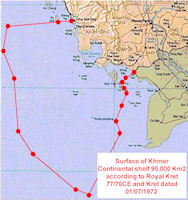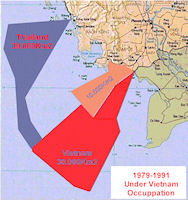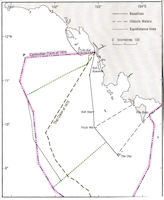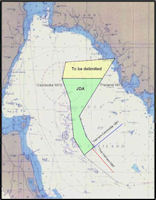Cambodia - Thailand Relations
Thailand shares its sea and land borders with Cambodia in the north and west. Its population is six times more than Cambodia's and its military power is much more modern than Cambodia's. It also has close military relations with the USA and conducts annual military exercises, such as Cobra Gold, with this country. Recently, and especially prior to the financial crisis, Thailand accelerated its military modernization program. Although some critics suggest that this modernization lead to a regional arms race, Cambodia believed that because of her economic improvement and her military relations with the USA, Thailand required such a military modernization program.
Thai-Cambodian relations in the 1960s were determined by the opposing positions each had taken concerning the struggle in Southeast Asia and the distrust existing between the two countries. Diplomatic relations were broken in 1961 after a name-calling incident between Prince Sihanouk and Premier Sarit Thanarat, which had resulted from Cambodian charges that Thailand had violated Cambodia's borders, intervened in its internal affairs and laid claim to a Cambodian temple located on the Thai-Cambodian border.
The tensions between Cambodia and Thailand were based more on recent occurrences than on traditional enmity. The Japanese cession of Cambodian territory to the Thai during World War II was regarded more as an incident involving the Thai and the French than one in which Cambodians were concerned intimately. Relations were relatively friendly between the end of World War II and independence. Culturally, the Thai were considered kinsmen, and Cambodia's Buddhist monks looked to Thailand for higher Buddhist education.
Cambodia has never thought of Thailand as a military threat to Cambodia's security. This opinion is premised on the view that Cambodia is not a competitor with Thailand, nor is there any evidence of a potential crisis that would cause Thailand to use military force against Cambodia.
There have been numerous examples of effective cooperation between the two countries. Cambodia and Thailand through effective cooperation solved the problem of Cambodian refugees located in Thailand. Repatriation to their native country of all Cambodian refugees was conducted successfully. In mid-1999, Thailand approached the Cambodian Ministry of Foreign Affairs suggesting joint maritime patrol along the sea border. The purpose of this patrol was to prevent the destruction of natural resources and clamp down on piracy. Cambodia welcomed the approach and hoped that it can respond positively in the future.
In 1907, Thailand (Siam) and France signed the François-Siamese Treaty with map attached. A considerable area of overlapping claims has resulted from Thai and Cambodian’s different interpretations over the 1907 treaty and selective use of Kut island base points. The Thai navy tended to enforce strict laws to implement its jurisdiction over the marine area, whereas the jurisdiction at Cambodian side was carried out by their weak marine police. The tension between the Royal Thai Navy and local Cambodian Marine Police included disputes over fishing boats in this area.
In 1997, the two countries sought a solution to their overlapping economic areas. After potential oil and gas-bearing structures was found on Thai waters by Idemitsu, Amoco, British Gas, Chevron, Unocal etc., Cambodia followed suit in late 1997, awarding four Conditional Petroleum Agreements covering the Joint Development Area to various consortia that included Bhpbilliton, Conoco, Enterprise, Idemitsu, Inpex and Marubeni. However, commencement of exploration is dependent upon satisfactory resolution by Cambodia and Thailand on their overlapping claims to the area.
In 2001, Cambodia and Thailand came to an agreement and signed a Memorandum of Understanding regarding the Area of their Overlapping Maritime claims to the Continental Shelf. Through subsequent negotiations, both countries indicated the possibility of establishing a joint venture in order to make possible the use of overlapping economic areas in the Gulf of Thailand. However, a question mark hangs over exploration for natural gas. While a lack of agreement remains about gas exploration, economic development in this area will remain out of reach, especially to Cambodia. Unsurprisingly, in 2007, Cambodia launched its priority policy to strengthen its naval force to protect its maritime interest.




Land border disputes between the two countries have arisen with only a number of incidents occurring. Because of wars and internal security concerns, Cambodia has not been able to maintain permanent control over the border. The continuing border defensive system established by Thailand in the 1980s, and other factors, resulted in the border line in some areas being unclear and needing to be inspected and resolve through negotiation. Because of these continuing border concerns the two countries agreed in 1996 to create a joint General Border Committee working from the local to the national level. This committee has worked in an attempt to resolve border issues. As a result of the committee’s efforts, security on the border was more stable, and trade corridors between the two countries were being opened regularly and securely.
Stoking resentment of Thailand is not difficult in Cambodia, where many people resent what they perceive as a Thai sense of superiority. There were violent demonstrations in Cambodia in 2003, when a Thai actress was rumored to have said Angkor Wat should belong to Thailand. The 2003 demonstrations escalated into a night of rioting and the burning of the Thai Embassy by a mob of Cambodian youths.
|
NEWSLETTER
|
| Join the GlobalSecurity.org mailing list |
|
|
|

